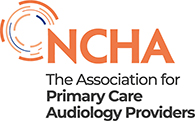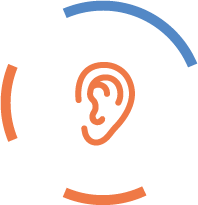Overview
In the UK over 11 million people have a hearing loss and 96% are aged 40 and over [1]. This is because age-related hearing loss is the main cause of hearing loss. Noise-induced hearing loss is the second leading cause of hearing loss in adults and accounts for an estimated 4% of hearing loss in people aged 15 to 79 [2]. For local prevalence data see the hearing map.
Learn more about
- Causes of hearing loss
- Age-related hearing loss
- Noise-induced hearing loss
- Other causes of hearing loss
Causes of hearing loss
Sensorineural hearing loss accounts for more than 90% of all hearing loss and in most cases, it is permanent and bilateral [3]. In the UK, age-related hearing loss is the single biggest cause of sensorineural hearing loss. The second most common form is noise-induced hearing loss. Less common causes include: genetic, side effects to certain medicines, infections (viral), Meniere's disease, systemic illness and other rare conditions.
Conductive hearing loss might account for as much as 8% of reduced hearing. There is often a mechanical cause - e.g. impacted wax, perforated eardrum [3]. It is usually temporary but can be permanent. There are medical and surgical treatments for certain forms of conductive hearing loss.
Age-related hearing loss (ARHL) is also known as presbycusis. It occurs due to irreversible damage to the hair cells of the cochlea and in most cases is bilateral and slowly progressive [3, 6].
- ARHL affects over 40% of people aged 50 or older [7]
- ARHL a long-term condition and in almost all cases [8] there is no medical or surgical treatment [9]
- Hearing aids remain the primary intervention
- In the UK the vast majority of people with hearing loss do not need to see an Ear, Nose and Throat (ENT) specialist or to go to hospital for hearing care, they can be managed by an audiologist in the vast majority of cases.
Noise-induced hearing loss (NIHL) is the second most common form of hearing loss. It is estimated that less than 1% of adults have NIHL [10]. Occupational NIHL has reduced in some countries because of improved safety standards at work [11].
- NIHL is one of the most common reasons for occupational disorders in Europe
- Like age-related hearing loss it occurs due to irreversible damage to the hair cells of the cochlea
- It can be prevented. Control of Noise at Work Regulations 2005 applies to all industry sectors in Great Britain and aim to minimise the risk of NIHL
- There are concerns that increased exposure to leisure noise might increase the prevalence of NIHL in the future - although the extent to which this will change overall prevalence of hearing loss remains uncertain
Other causes of hearing loss can be temporary or permanent, but they are relatively rare when compared to age-related and noise-induced hearing loss. For example, chronic inflammation of the middle ear, also known as chronic ottis media, is thought to affect less than 1% of the population in the UK [12]. It can be treated, but in some cases it can result in permanent conductive hearing loss. It is a leading cause of conductive hearing loss but still a rare form of hearing loss relative to aged-related hearing loss [13].
The table below provides a list of conditions that can result in hearing loss [14]. It is not an exhaustive list and does not add up to 100% because prevalence of hearing loss is given for each condition, not the proportion that each condition accounts for.
|
Cause of hearing loss |
Sensorineural |
Conductive |
How common is it? |
Learn more? |
|
Age-related hearing loss (presbyacusis). No medical or surgical treatment. Permanent |
|
Very common. Single biggest cause of hearing loss. >40% of people aged 50+ [15] |
|
|
|
Earwax [16] Temporary |
|
|
3.9% [17] |
|
|
Noise-induced (occupational) hearing loss. No medical or surgical treatment. Permanent |
|
|
<1% of adults [18]
|
|
|
Permanent childhood hearing loss (prelingual and postlingual). |
|
|
0.08% to 0.3% in children (age 0-17) [19] |
|
|
Middle ear disease (Ear inflammation/infection (e.g. otitis media with effusion, chronic otitis media, acute otitis media, other bacterial, viral etc). |
|
|
Temporary hearing loss most likely. Unknown how many cases result in permanent hearing loss.
|
NICE - chronic otitis media NICE - acute otitis media
|
|
Meniere's disease - most common in the fourth decade of life |
|
|
0.1% [20] |
|
|
Otosclerosis |
|
|
0.06% [21] |
|
|
Sudden idiopathic sensorineural loss |
|
|
0.02% [21] |
|
|
Cholesteatoma |
|
|
0.01% [21] |
|
|
Hearing loss in multiple sclerosis Often temporary |
|
|
0.01% [21] |
MS - USA MS - UK |
|
Labyrinthitis |
|
|
0.004% [21] |
|
|
Vestibular schwannoma or other retrocochlear mass (e.g. neural tumour) |
|
|
0.002% [22] |
|
|
Ototoxic drugs
|
|
|
Unknown how many cases result in permanent hearing loss |
|
|
Perforated eardrum (can be traumatic, but most cases are due to otitis media) |
|
|
|
|
|
Eustachian tube dysfunction - common in children under the age of 5 [23] |
|
|
|
|
|
Other - Foreign body, trauma (e.g. temporal bone fracture, external ear-canal trauma, vertebral artery dissection etc.), benign growths (e.g., exostosis, osteoma, polyps, External ear canal neoplasm) |
|
|
|
Originally published: 2016
Reviewed: September 2020
Next review date: September 2021
Info: Page content updated as part of migrating content to a new website platform.
Reference and notes
[1] Age is the biggest single cause of hearing loss. Hearing loss that develops as a result of getting older is often known as age-related hearing loss or presbycusis. Most people begin to lose a small amount of their hearing from around 40 years of age. This hearing loss increases as you get older. By the age of 80, most people have significant hearing problems. As your hearing starts to deteriorate, high-frequency sounds, such as female or children's voices, may become difficult to hear. It may also be harder to hear consonants such as "s", "f" and "th". This can make understanding speech in background noise very difficult
[2] Calculated by the NCHA. Population statistics ONS, 2015, Table SAPE17DT5: Mid-2014 Population Estimates for Clinical Commissioning Groups in England, by Single Year of Age and Sex. Prevalence of hearing loss age 15-17: estimated at 0.3%. Prevalence of hearing loss age 18-79: Davis, Adrian (1995), "Hearing in Adults. The prevalence and distribution of hearing impairment and reported hearing disability in the MRC Institute Hearing Research's National Study of Hearing", MRC Institute of Hearing Research, Whurr Publishers Limited, London. % of hearing loss attributed to noise induced hearing loss in people aged 15-79 based on UK being in WHO region EURA and table VIII in Nelson D. et al. 2005. The global burden of occupational noise-induced hearing loss. American Journal of Industrial Medicine. The following age-group bands were used for both female and male (15-17)(18-29)(30)(31-40)(41-40)(41-44)(45-50)(51-59)(60)(61-69)(70)(71-79). Prevalence of hearing loss was calculated and then the % attributed to noise derived from that based on guides given by Nelson et al. Then the final number summed and compared to the total number of adults (18+) with hearing loss in England. 8.863967 million adults (18+) estimated to have a hearing loss of at least 25dBHL in better ear, and 332,743 to have noise induced hearing loss
[3] Yueh, B. et al. 2003. Screening and Management of Adult Hearing Loss in Primary Care: Scientific Review. JAMA: Journal of the American Medical Association, 289(15), pp. 1976-1985
[4] Barker, F. et al, 2014. Interventions to improve hearing aid use in adult auditory rehabilitation (Protocol). Cochrane Database of Systematic Reviews: Reviews 2014; Issue 7
[5] Davis, A. et al., 2007. Acceptability, benefit and costs of early screening for hearing disability: a study of potential screening tests and models. Health technology assessment, 11(42),
[6] Huang, Q. and Tang, J. 2010. Age-related hearing loss or presbycusis. European Archives of Otorhinolaryngology, 267(8), pp. 1179-1191.
[7] Zahnert T. The Differential Diagnosis of Hearing Loss. Deutsches Ärzteblatt International. 2011;108(25):433-444. doi:10.3238/arztebl.2011.0433. estimate that 40% of people aged 65 and over have hearing loss. Based on 2014 ONS statistics for England, the NCHA estimates for hearing loss in adults aged 50 and over is 42%, most this hearing loss is likely to be age-related hearing loss.
[8] Cochlear implants (CIs) can bypass the damaged hair cells of the cochlear and stimulate the vestibulocochlear nerve directly. NICE guidelines on CIs can be found here
[9] Barker, F. et al, 2014. Interventions to improve hearing aid use in adult auditory rehabilitation (Protocol). Cochrane Database of Systematic Reviews: Reviews 2014; Issue 7
[10] Calculated by the NCHA. Population statistics ONS, 2015, Table SAPE17DT5: Mid-2014 Population Estimates for Clinical Commissioning Groups in England, by Single Year of Age and Sex. Prevalence of hearing loss age 15-17: estimated at 0.3%. Prevalence of hearing loss age 18-79: Davis, Adrian (1995), "Hearing in Adults. The prevalence and distribution of hearing impairment and reported hearing disability in the MRC Institute Hearing Research's National Study of Hearing", MRC Institute of Hearing Research, Whurr Publishers Limited, London. % of hearing loss attributed to noise induced hearing loss in people aged 15-79 based on UK being in WHO region EURA and table VIII in Nelson D. et al. 2005. The global burden of occupational noise-induced hearing loss. American Journal of Industrial Medicine. The following age-group bands were used for both female and male (15-17)(18-29)(30)(31-40)(41-40)(41-44)(45-50)(51-59)(60)(61-69)(70)(71-79). Prevalence of hearing loss was calculated and then the % attributed to noise derived from that based on guides given by Nelson et al. This gives an estimated 332,734 people aged 15-79 with noise-induced hearing loss out of a population of 41,639,332, with an estimated prevalence of 0.8%
[11] Lie. et al. Occupational noise exposure and hearing: a sysemtatic review doi:10.1007/s00420-015-1083-5
[12] NICE, 2013, Otitis media - chronic suppurative. CKS. http://cks.nice.org.uk/otitis-media-chronic-suppurative#!topicsummary accessed 22 January 2016
[13] Zahnert T. The Differential Diagnosis of Hearing Loss. Deutsches Ärzteblatt International. 2011;108(25):433-444. doi:10.3238/arztebl.2011.0433.
[14] Note: This list was compiled from the following resources: Michael Gleeson et al. 2008, Scott-Brown's Otorhinolaryngology, Head and Neck Surgery, Volume 3. Edward Arnold (Publishers) Ltd; Zapala, D. A. et al 2010. Safety of Audiology Direct Access for Medicare Patients Complaining in Impaired Hearing. Journal of the American Academy of Audiology, 21(6), pp. 365-379; Zahnert T. The Differential Diagnosis of Hearing Loss. Deutsches Ärzteblatt International. 2011;108(25):433-444. doi:10.3238/arztebl.2011.0433; BMJ Best Practice, 2015. Assessment of Hearing Loss; NHS Choices, Causes of Hearing Loss - accessed 1 February 2016
[15] Zahnert T. The Differential Diagnosis of Hearing Loss. Deutsches Ärzteblatt International. 2011;108(25):433-444. doi:10.3238/arztebl.2011.0433. estimate that 40% of people aged 65 and over have hearing loss. Based on 2014 ONS statistics for England, the NCHA estimates for hearing loss in adults aged 50 and over is 42%, most of this hearing loss is likely to be age-related hearing loss.
[16] Not all earwax will result in an individual seeking help from a health care professional. The actual prevalence of earwax varies with age: 0 to 16 years: 10% to 43%. 16 to 59 years of age: 2% to 5%. ≥60: 16% to 57%, Ref: Cited in: The safety and effectiveness of different methods of ear wax removal: a systematic review and economic evaluation. Clegg et al. Health Technology Assessment
[17] Guest, J.F. (2004). Impacted cerumen: composition, production, epidemiology and management. Q J Med 2004; 97:477-488 doi:10.1093/qjmed/hch082.
Note, 3% to 6% in adults. 10% in children. Possibly higher in older adults due to changes in the ceruminous glands with age Ref: Roeser RJ, Balachanda BB. Physiology, pathophysiology and anthropology/epidemiology of human ear canal secretions. J Am Acad. Audiology. 8:391-400. Cited in BMJ Best Practice. Mar. 10. 2015 version of cerumen impaction
[18] Calculated by the NCHA. Population statistics ONS, 2015, Table SAPE17DT5: Mid-2014 Population Estimates for Clinical Commissioning Groups in England, by Single Year of Age and Sex. Prevalence of hearing loss age 15-17: estimated at 0.3%. Prevalence of hearing loss age 18-79: Davis, Adrian (1995), "Hearing in Adults. The prevalence and distribution of hearing impairment and reported hearing disability in the MRC Institute Hearing Research's National Study of Hearing", MRC Institute of Hearing Research, Whurr Publishers Limited, London. % of hearing loss attributed to noise induced hearing loss in people aged 15-79 based on UK being in WHO region EURA and table VIII in Nelson D. et al. 2005. The global burden of occupational noise-induced hearing loss. American Journal of Industrial Medicine. The following age-group bands were used for both female and male (15-17)(18-29)(30)(31-40)(41-40)(41-44)(45-50)(51-59)(60)(61-69)(70)(71-79). Prevalence of hearing loss was calculated and then the % attributed to noise derived from that based on guides given by Nelson et al. This gives an estimated 332,734 people aged 15-79 with noise-induced hearing loss out of a population of 41,639,332, with an estimated prevalence of 0.8%
[19] Estimates of hearing loss of ≥25dB HL in better ear in children are not readily available. The data in the table only provides estimates and gives a range due to the uncertainty associated prevalence of hearing loss in childhood. Sources: M Bond et al. 2009. The effectiveness and cost-effectiveness of cochlear implants for severe to profound deafness in children and adults: a systematic review and economic model. Health Technol Assessment 2009.DOI: 10.3310/hta13440; CDC international collection of prevalence of hearing loss - http://www.cdc.gov/ncbddd/hearingloss/data.html accessed 21 February 2016; and NDCS estimates of 3 in 1000.
[20] Minor, L.B, e al. 2004. Meniere's disease. Current Opinion in Neurology17(1), 9-16. Cited in NICE, 2012. Meniere's disease. http://cks.nice.org.uk/menieres-disease#!topicsummary
Note. Primarily a disease of adulthood occurring in the fourth decade of life. [BMJ Best Practice, Meniere's disease, 17 December 2014]
[21] Zapala et al., (2010) provide the highest estimates of conditions that would require medical review, whilst their study is based in the United States, their estimates are from the literature and therefore can be generalised. Ref: 10 - Cited in Zapala, D. A. et al 2010. Safety of Audiology Direct Access for Medicare Patients Complaining in Impaired Hearing. Journal of the American Academy of Audiology, 21(6), pp. 365-379.
[22] Zapala et al., (2010) provide the highest estimates of conditions that would require medical review, whilst their study is based in the United States, their estimates are from the literature and therefore can be generalised. Ref: 10 - Cited in Zapala, D. A. et al 2010. Safety of Audiology Direct Access for Medicare Patients Complaining in Impaired Hearing. Journal of the American Academy of Audiology, 21(6), pp. 365-379.
Alternative source: The Annual incidence of acoustic neuroma has also been reported as being 0.001% to 0.002%, with smaller tumours being detected because of the increased use of MRI. Between 40% and 60% of small tumours might not require treatment, and where managed effectively the prognosis for other people is good [BMJ Best Practice, 5 June 2015, Acoustic neuroma].
[23] BMJ Best Practice 2016. Eustachian tube dysfunction

 Your hearing and aural health
Your hearing and aural health  Commissioners and Policymakers
Commissioners and Policymakers  Member support and guidance
Member support and guidance News and views
News and views
 Hearing map
Hearing map

